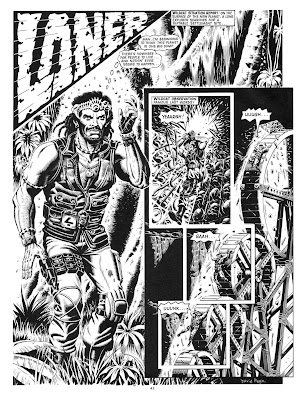Book Review: 'Strangers' by Gardner Dozois
‘Strangers’ first appeared as a novelette in the 1974 anthology New Dimensions IV, edited by Robert Silverberg. Dozois received sufficient interest from publishers to expand 'Strangers' into a novel, which was issued in hardcover in 1978.
This Berkley Books mass market paperback edition (166 pp.) of the expanded 'Strangers' was published in December, 1978. The cover artist is uncredited.
‘Strangers’ is set on the planet of Lisle; the country of Shasine; the city of Aei. Lisle is populated by a race of Vaguely Otter-ish humanoids known as the 'Cian'. The novel’s protagonist is a young German man named Joseph Farber, who works as a photographer for the Terran Mission to Lisle.
Self-absorbed, and often consumed with self-pity, Farber is neither a companionable fellow, nor very bright. As the novel opens, Farber – alienated from his fellow Mission staffers – wanders the night-time streets of Aei, where a festival is taking place. He meets a young Cian woman named Liraun, who is alienated from her own society, and an improbable interspecies romance begins.
When his fellow Terrans, and the elders of Cian society, disapprove, it serves only to spark petulance in Farber, and he makes a fateful decision to submit to the biotech scientists of Cian. The biotech scientists permanently alter his genetic makeup, allowing him to father children with Liraun. Subsequently, the two marry according to Cian rites, and set up house together in the Old Quarter of Aei.
Farber has, for the first time in his life, found a measure of happiness. But as time goes on, an awareness filters into his consciousness that the inscrutable nature of Cian culture hides some very disturbing secrets….and he has blundered into a situation from which there is no easy egress...........
Some novelettes can survive being expanded to novel length, but in my opinion, ‘Strangers’ might better have been left as a shorter piece. To flesh out the narrative and its simple, straightforward plot, author Dozois relies on inserting dense passages, related in poetic and ornate language, that expound on the enigmatic behaviors and rituals of the Cian, while ever-so-slowly advancing the novel towards its Big Revelation. Negotiating these passages of the novel can require determination.
The Big Revelation, when it does arrive, is effective.
‘Strangers’ is a novel whose deliberate, contemplative storyline may be rewarding to those sci-fi fans who like stories revolving around alien sociology and psychology, a topic much explored during the height of the New Wave Era. However, those readers looking for a fast-moving, action-oriented narrative will not find it in the pages of this novel.

















































.jpg)



















